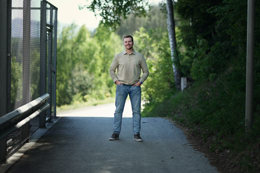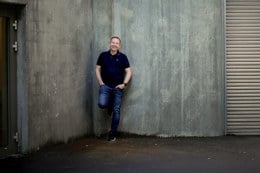
Designing for a sustainable future
At Kongsberg Maritime, sustainability isn’t a separate initiative - it’s part of how we design, build and improve our products. Meet Elisabeth Lervåg Synnes, Product Sustainability Lead in the Propulsion and Handling division, whose work helps engineers turn sustainability targets into practical design decisions.
-
Text:Christine Oulie
Photo:©Andres Vargas
Meet Elisabeth: a specialist role with a practical focus

As product sustainability lead, Elisabeth supports engineering teams with the data, tools, and processes they need to make informed, responsible design decisions. “I see my role as enabling engineers to work with sustainability in mind - without adding unnecessary complexity,” Elisabeth says. “That means making sure they have access to the right materials, data, and systems at the right time.”
She heads the Material Compliance Team, which maintains Kongsberg Maritime’s approved materials library, ensures compliance with substance regulations, and supports bill of materials (BOM) analysis.“It’s about making sure we use the right materials - and that we can document what goes into our products,” she explains.
Elisabeth also leads the implementation of tools that integrate sustainability into everyday engineering. These include our Integrated Material Management module which automates compliance processes, and a lifecycle assessment (LCA) tool currently being evaluated to help quantify environmental footprints from raw materials to end of life.
“These tools are not just for reporting - they help our product teams make better decisions early in the design phase,” she says. “Choices around materials and design have the biggest influence on a product’s environmental footprint. If we can bring sustainability data in early, we can balance environmental performance with quality, time, and cost.”
Turning targets into action
KONGSBERG has set ambitious climate targets for 2030, developed in alignment with the Science Based Targets initiative and the goals of the Paris Agreement. One of the key focus areas is Scope 3 emissions - indirect emissions that occur across the value chain. Elisabeth’s role is to help translate these targets into practical steps at the product level.
Scope 3 targets
Our goals for cutting indirect emissions from the value chain
-
of our suppliers will set science-based CO2 emission reduction targets within the next 5-year period
/3 -
reduction in emmisions from use of sold products
10% -
reduction in emmissions from business travel per employee
15% -
reductions in emmissions from upstream transportation and distribution per ton/km
10%
“We calculate emissions based on a 25-year product lifetime,” she explains. “We look at rated power, operational factors, fuel type, and usage patterns. My job is to ensure we use consistent, accurate data so we can plan realistic paths to reach our targets.”

Supporting engineers with the right tools Elisabeth describes her role as being a reliable point of contact rather than a keeper of all answers:
“To me, being a specialist means being someone a product engineer can come to for guidance on how to align design requirements with our sustainability indicators,” she says. “I may not always have the answer immediately, but I know where to look and I’ll help figure it out.”
She works closely with other engineers to ensure tools and data are genuinely useful.“Engineers are the end users of our systems. If we don’t understand how they work, we can’t support them effectively.”
Her background in production helps bridge sustainability goals with engineering reality. “It’s easier to have meaningful conversations when you understand the constraints. I try to bring that perspective into everything I do.”
From engineering to sustainability
Elisabeth’s career path has always been hands-on. After completing a master’s degree in technology management at NTNU, she joined Kongsberg Maritime’s graduate programme, working with thrusters in Ulsteinvik, hydraulic motors and steering gears in Brattvåg, and later winch production in Vietnam.“That experience gave me a strong foundation in how products are developed and manufactured,” she says.
She later pursued an industrial PhD, exploring how low-volume industries can transform assembly through automation - combining academic research with real-world challenges. After completing her PhD, Elisabeth became Engineering Operations Lead before stepping into her current sustainability role.
"The biggest difference now is that I work across multiple product groups and focus more on systems, tools and processes. But my background in production is still very relevant - it helps me understand the practical side of what we’re trying to achieve"
Always learning, always improving
What Elisabeth enjoys most about her work is its variety. “Two days are never the same. I might be working on a new tool rollout, analysing emissions data, or collaborating with a team on a specific challenge. It’s a very hands-on and dynamic role.”
She also values the learning culture at Kongsberg Maritime.
“We work with internal experts, research projects, and industry collaborations - and we learn a lot from our customers too. That’s one of the benefits of working here: you’re always learning.”
For Elisabeth, the motivation is clear: “I chose this field because we can make a real difference. By integrating sustainability early in the design phase, we can influence both environmental performance and product quality. That’s where I want to contribute.”
Her journey shows how technical expertise and practical understanding can drive meaningful change - connecting strategic goals with day-to-day engineering decisions.
Elisabeth’s work reflects Kongsberg Maritime’s approach to sustainability: measurable, transparent, and collaborative. Her team’s efforts help ensure that sustainability data is available at the design stage so every product decision is informed by both performance and environmental impact.
Different Paths, same curiosity
Meet Reidar, Jens-Ingeman, and Sondre - engineers at Kongsberg Maritime who each bring deep expertise in their field. Their career paths and technical focus areas are quite different, but they share one important trait: curiosity. If you're curious about what technical career paths looks like in practice, take a look at their stories.
- Junior Automation and Mechatronics EngineerLocation:Kongsberg Maritime Poland Sp. z o.o, Szczecin, Polskaread more
- Project EngineerLocation:Kongsberg Maritime - Global Customer Support, Trondheimread more
- Junior Hardware EngineerLocation:Kongsberg Maritime Poland Sp. z o.o, Szczecinread more
- Workshop TechnicianLocation:Kongsberg Maritime Netherlands, Spijkenisse, NLread more
- Team Manager, Loading & StabilityLocation:Kongsberg Maritime - Global Customer Support, Trondheimread more
- Team Manager - Field Service, KongsbergLocation:Kongsberg Maritime - Global Customer Support, Kongsbergread more
- Technical Support Engineer - Automation SystemsLocation:Kongsberg Maritime Poland Sp. z o.o, Szczecin, Polskaread more
- Senior Technical Support EngineerLocation:Kongsberg Maritime Poland Sp. z o.o, Szczecin, Polskaread more
- International Service EngineerLocation:Kongsberg Maritime Poland Sp. z o.o, Szczecin, Polskaread more
- Summer Job 2026Location:Kongsberg Maritime - Propulsion & Handling, Kristinehamn, Swedenread more

